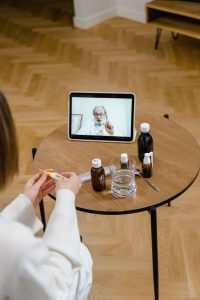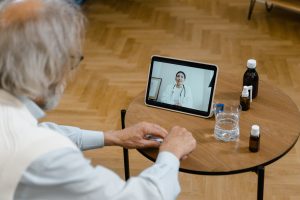No one could accuse doctors of phoning it in during the pandemic. But with the advent of telehealth, many did just that – and their patients loved it.
Virtually essential
Telehealth was already on the rise before Covid-19 came on the scene. In the midst of lockdowns, quarantining, travel restrictions and uncertainty, being able to consult with a doctor over the phone or via a video call became an essential part of healthcare. Even after restrictions were lifted, telehealth remained popular for both patients and doctors. For people who are unwell, far away, busy, in financial difficulty, fearing stigma, or otherwise unable to travel, telehealth can mean the difference between attending an appointment or cancelling – or even being able to see a doctor in the first place.
Ringing in the changes
In specialties where patients need regular check-ins but don’t need regular check-ups, a mix of in-person and telehealth consults can make care both more convenient and effective. Endocrinology in particular is well-suited to telehealth, as endocrine diseases are often detected and treated based on reported symptoms, patient history, blood tests, and imaging results, rather than immediate observations of a person’s body. As such, endocrinologists are on the forefront of this shift to virtual medicine, with follow-ups for endocrine conditions being some of the most common reasons patient in the US use telehealth.
Answering the call
However, as telehealth is still relatively new and had to be introduced to practices and patients hurriedly during a health emergency, there is still little data on how to use it best.
The American Endocrine Society convened a panel of 9 endocrinologists with expertise in the area to investigate this matter for its members. Last year the panel published a set of recommendations in The Journal of Clinical Endocrinology & Metabolism to guide doctors’ use of telehealth.
The guidelines: a summary
The panel began by conducting a review of existing research. From this analysis, they identified 5 particular areas of importance: clinical, the doctor, the patient, the patient-doctor relationship, and health care setting and technology.
Clinical
In terms of workflow, a doctor might prefer to see all new patients in person to establish trust – or alternatively, they might prefer to see all new patients via telehealth and then assess whether they need a physical examination to save everyone some time and expense.
However, both patients and doctors usually prefer to meet in person for significant events like a diagnosis, poor prognosis, complex situations, sensitive topics, treatment decisions, retrieving records, or physical exams. This suggests that context is important when given a choice between telehealth or an in-person consult, and that the choice be available to both doctors and patients.
That said, physical exams can be facilitated by telehealth in certain circumstances. Depending on the test, a GP could perform the appropriate tests and forward the results. In other cases, some members of a multidisciplinary team can be present with the patient while others attend virtually. In these situations, telehealth can still be a good option for the endocrinologist.
The panel recommends that at each appointment, doctors should carefully think about their patient’s current and anticipated clinical needs when deciding whether a telehealth or an in-person appointment would be most appropriate for their next consultation.
The doctor
By now, most endocrinologists, even the newest ones, would have attended to a patient via a telehealth consultation. However, very few have received formal training for this particular method of healthcare.
This means that doctors vary wildly in their digital literacy, experience and skills, which can affect the quality of the consultation.
To address this disparity, the panel recommends medical education include formal training in key telehealth skills such as techniques for patient engagement, remote data analysis, integrated team care via telehealth, and guiding patient self-examination.
The patient
Patient-centred care emphasises the role of the patient in their own care. It improves clinician and patient satisfaction, encourages high levels of patient participation, and improves health outcomes.
As such, the panel recommends that the patient’s preference should be taken into account when deciding whether a telehealth appointment is appropriate.
One thing that may influence patient preference is the world they live in. Not everyone has a computer, a webcam, excellent broadband, technical knowledge, a quiet place to sit, privacy, a good phone connection, or a phone of their own.
Patients who aren’t technologically adept, have low health literacy, speak languages other than English, or have hearing or speaking impediments can find attending telehealth appointments particularly difficult and might not get as much from a virtual consultation as an in-person visit.
Because of this, the panel advises doctors to advocate for health equity to ensure everyone can benefit from advances in healthcare equally.
Patient-doctor relationship
Patients and doctors can find it more difficult to establish an emotional connection through phone and video calls. It’s much harder to read body language if the patient and doctor can’t see each other’s bodies, and non-verbal cues don’t translate well through audio. Similarly, patients feel more confident with their doctor’s decisions if the doctor has performed an in-person physical exam.
As a patient usually takes a telehealth call at home, their relationship to their doctor during a consult is also likely to be affected by their sense of privacy – whether other family members can listen in, or whether the doctor can see into their house. This concern can often be alleviated by setting up expectations before the call.
Talking to people at their home also means that the patient is surrounded by their everyday resources, such as caregivers, medications, devices, and reminders of their routine, which can be useful during a consultation. However, it also means it can be more difficult for doctors and patients to look at things like test results or diagrams together.
Healthcare setting and technology
Integrating telehealth into traditional workflows can be challenging. With staff all working from different locations, practices have to make sure that everyone can keep in contact with everyone else and they all have access to equipment, technology, and support that is interconnected, working, and updated.
The panel recommends that before a telehealth consultation, support staff from the practice should be available to help patients access the appointment and upload any data or documentation.
People with diabetes might need to upload data from their glucose meter, continuous glucose monitor, insulin pump, or their own records. The panel recommends the use of secure, internet-based diabetes data platforms that allow for passive data upload and easy access by the doctor. Otherwise, support staff from the practice should instruct the patient how to upload the data from their devices manually, or connect them with a local GP clinic that can help with this process.
Ideally, practices should have support staff on hand to virtually room patients before video-call appointments, as this has been shown to help patients complete their telehealth appointment. Having support staff on hand for checking in and checking out of an appointment also means that contact information can be gathered or updated, vital signs reported, interpreter services organised, late apologies given, last-minute requests followed-up, and the next visit scheduled.
Conclusions
In the end, the panel could not recommend any specific minimum intervals for in-person care, as there wasn’t enough evidence to say either way in the academic research, and no clear consensus currently exists amongst endocrinologists in the field.
They emphasised that more research is needed before the effect of telehealth on short-term and long-term clinical outcomes, patient satisfaction, cost and cost-effectiveness, definitions of success, and the effect on the population in terms of access and outcome is really known.
Admittedly, there hasn’t been much research on this in terms of in-patient care either, but as telehealth is new, it has both an opportunity and an onus to prove itself.
The panel points out that access to telehealth is dependent on access to technology, digital and language literacy, and privacy, and calls for interventions that aim to close the digital divide.
They also warn that practices dependent on telehealth run the risk of doctors feeling dissatisfied and suffering burnout. As such, they recommend that doctors’ needs, as well as patient needs, be taken into account when developing practice workflows.
Finally, they advocate for setting up structured clinical workflows for telehealth encounters and developing standardised approaches for delivering team-based care over telehealth.
Overall, the panel accepts that telehealth is here to stay, and sees great benefit in being able to deliver care to those not able to make it into a doctor’s office. As endocrinololgy is well-situated to this kind of care, it’s likely to be at the forefront of what this new mode of care has to offer.












